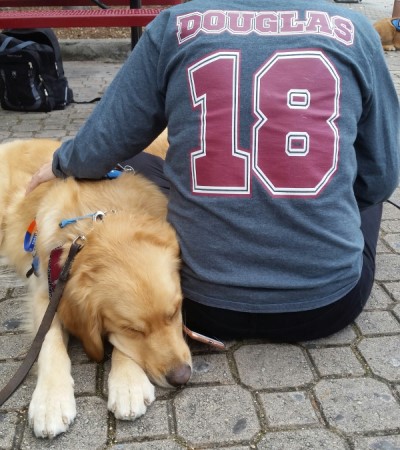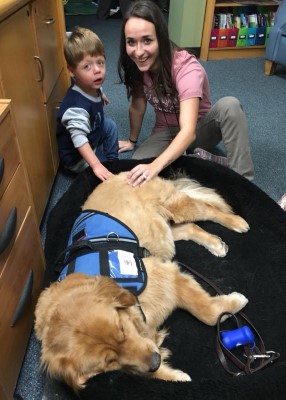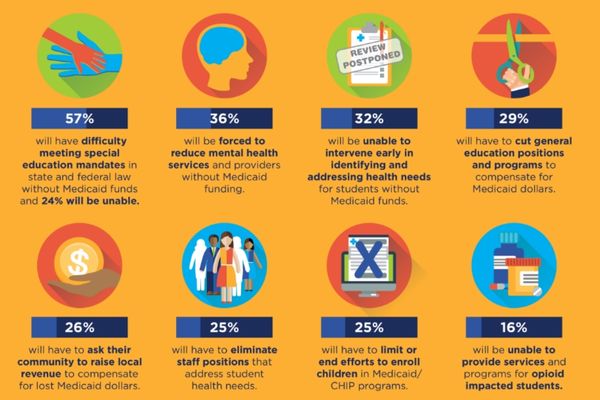Comfort in Crisis
February 01, 2019
Therapy dogs in classrooms offer support to children stricken by trauma and others learning to read

Two weeks after a gunman killed three staff members and 14 classmates one year ago at Marjory Stoneman Douglas High School in Parkland, Fla., students returned to campus, where they were greeted by 60 therapy dogs. In the following days, many students reported the dogs were “the only reason they came back to school,” says Mary Claire Mucenic, school psychologist and support services director for Broward County Public Schools.
At the Bettendorf Community School District near Davenport, Iowa, 4th graders in one classroom are rewarded for good work and positive behavior with time in the dog house, where they read to Ranger, a St. Bernard mix trained as a therapy dog.
Every day at school in a Portland, Ore., suburb, a service dog named Benny calms 3rd grader Johnny Mentesana, who suffers from a sensory processing disorder. Before the dog arrived, Johnny spent most of his time isolated from classmates because of anxiety and emotional outbursts.
Canine Presence
Specially trained canines are showing up in classrooms across the country to comfort, reward and serve students in ways that school administrators say improves their success while at school. Therapy dogs comfort children in the wake of tragedies, relieve their anxieties and listen to them talk as they practice their reading or discuss a problem. Some school districts have been reluctant to admit canines because of liability concerns about harming children allergic to dogs or deeply afraid of them. But in the wake of feel-good publicity over animal use in the recovery of trauma-affected children, educators appear to be feeling more pressure to allow dogs into their schools.
An agency based in the suburbs of Chicago in the business of managing therapy dog assignments has experienced rapidly rising demand. Lutheran Church Charities’ K-9 Comfort Dog Ministry in Northbrook, Ill., has grown from four dogs in 2008 to 130 dogs today in more than 20 states. The firm primarily responds to school crises and natural disasters.
School districts with a history of therapy dog use typically have well-formulated rules governing the use of dogs and the role of handlers. The Bettendorf schools in Iowa require dogs be groomed, immunized and trained. The handlers must be certified and adhere to guidelines for ethical behavior. The Beaverton School District, near Portland, Ore., is seeing more therapy dogs in schools so it is devising “an approval process including assessing the educational benefit for having a therapy dog,” says district spokeswoman Maureen Wheeler.
But how do dogs benefit students? Much research on the long-term effects of dogs on student learning has been flawed by small sample sizes, lack of control groups and other problems, researchers say. Solid research, however, does show dogs have a short-term calming effect on children. Just touching a dog can reduce a student’s anxiety and blood pressure. That’s why dogs are brought onto campuses after school shootings.
Comfort in Parkland
Newtown Public School District in Connecticut welcomed Lutheran Church Charities dogs after 20 children and six adults were murdered at Sandy Hook Elementary School on Dec. 14, 2012, and the dogs remain, says Superintendent Lorrie Rodrigue, who joined the district as the high school principal two years after the fatal shootings.
“Everyone in the community feels that to bring these animals in is one concrete and supportive strategy to help our families, staff and students,” she says. “When you see it in this context of post tragedy in a community like this, it brings joy, a sense of joy and health.”
Broward County Public Schools, the nation’s sixth largest district, did not initially call for therapy dogs in the aftermath of the Marjory Stoneman Douglas High School tragedy, says Mucenic, the school psychologist. But handlers from local groups brought dogs, she says, and staff and students immediately saw the benefit. The dogs are trained not to bark, bounce or disrupt. With their vests on, they know they are at work — calm and attuned, ready to listen and to be petted and hugged.
The dogs not only comforted students but also “highly stressed” administrators at the district office, Mucenic says. Volunteer handlers from a variety of agencies continue to visit the high school with their dogs.
Handlers with Lutheran Church Charities usually work through local churches or schools. They have responded to most mass shootings since Sandy Hook.
“We never go anywhere where we are not invited,” says Tim Hetzner, president and CEO for Lutheran Church Charities, which does not charge for providing comfort dogs.
The agency invests more than $2,000 per dog, always a golden retriever, to provide its own 18 to 20 months of training. The dogs learn to work with multiple trained handlers. Kids like the dogs because they “are good listeners and nonjudgmental,” Hetzner says.
After the shooting at Sandy Hook, one young survivor went four days without talking to anyone. Then his parents led him to a dog.
“The boy lay down on top of the dog,”
Hetzner says. “He lifted up the ear of the dog and told the dog what happened in that classroom.”

Support in Learning
Even without a crisis, some districts have long used therapy dogs to comfort students and help them with academics. They report the dogs are widely popular and rarely invite complaints. Bettendorf, a bedroom community to Davenport, Iowa, already was using therapy dogs when Michael Raso arrived 11 years ago to become superintendent. The 4,000-student district’s foundation and PTA paid for the purchase and training of a therapy dog for each of the six elementary schools.
The district says its dogs provide emotional support, model good behavior, provide stress relief, inspire a love of reading, teach kindness and improve trust and socialization.
Bettendorf teachers, counselors, a secretary and librarian have volunteered to be trained as handlers with some assuming responsibility to feed and care for dogs in their homes.
Teacher Jodi Hanson handles a black Labrador retriever named Akin in her 4th-grade classroom at Neil Armstrong Elementary. Pairs of students take turns reading to or sitting by the dog while completing schoolwork. Students with trouble verbalizing problems can talk to Akin. The dog spends one day a week in the school library where children read to him.
“Today our new counselor came to get him because a student was having a hard time transitioning from home,” says Hanson.
Fitchburg Public Schools leads Massachusetts in using therapy dogs. A local organization, Be PAWSitive Therapy Pets, provides dogs weekly in most of Fitchburg’s seven elementary and middle schools to help children improve their reading and moderate their behavior. Shortly after he arrived nine years ago at Michigan’s Brighton Area Schools, a 6,000-student district 45 miles northwest of Detroit, Superintendent Greg Gray agreed to try a therapy dog named Caesar in one school at a teacher’s request.
“We saw such a benefit in his interaction with kids and with kids who are struggling,” Gray says.
The district now has four dogs and is training five more, each of which costs about $8,000, so it will have a dog working in every school.
Service Dogs
Service dogs also have grown common in schools. Unlike therapy dogs, service animals are trained to support students with specific needs, such as blindness, autism or emotional problems. Districts get into court battles when they try to bar service dogs, which they must accommodate under the Americans with Disabilities Act.
Hollie and John Mentesana of Tigard, Ore., struggled for years to help their son, Johnny, now in 3rd grade, adjust at Metzger Elementary School. His auditory and sensory processing disorders and deep anxiety make him prone to outbursts of anger or tears over a teacher’s question about his school work, a reprimand or a noisy classroom.
“Kindergarten was kind of a wash because it was so emotionally difficult,” says Hollie Mentesana.
Her son spent most of his 1st-grade days separated from class with his aide. Then he was joined by Benny, a yellow Labrador trained over a year to be his service dog, and the emotional outbursts nearly disappeared. And when they do occur, Benny dashes to Johnny, leans into him and quickly settles him down.
“The touch is calming,” says John Mentesana. “It resets him. It distracts him and helps him handle things.”
More districts are weighing whether to provide access for more students to the comforting touch of dogs. The Brighton district has fielded inquiries and visits from dozens of school leaders interested in therapy dogs, and Gray, the superintendent, says he encourages his colleagues from other communities to take a look at the therapists on four legs.
“Once you’ve seen them in action,” he says, “you will be a believer.”
About the Author
Bill Graves is a freelance education writer based in Beaverton, Ore.
Additional Resources
Several informational resources on the use of pet therapy in schools.
Charlotte’s Litter, a nonprofit organization that manages therapy dogs in schools nationwide
“The Healing Power of Dogs,” National Geographic article on therapy dogs
Lutheran Church Charities K-9 Comfort Dog Ministry, based in Northbrook, Ill., offers guidelines on the use of comfort dog visits
School Therapy Dogs, a website with practical information
Advertisement
Advertisement
Advertisement
Advertisement




